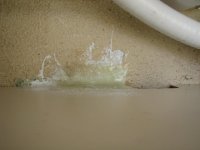I haven't done this with the exception that I did redo the screws into the sole of the cabin floor of my 22. I also had the through holes in the hull (transducer and plug) taken apart and re-sealed about 1/2 through my ownership. I'll be interested to see what you learn as you go through this. Also, the "factory" installs are not the only source of worry. A lot of the holes/components on the boat are dealer installed and the quality of those installs varies widely. Once it warms up some, I plan to deal with a few items on the Tomcat that were not installed the way I would like them to be. However, I have to admit that when I got my 1st boat, I really didn't know what to look for or what questions to ask. I'm in much better shape now due to learning from others on this site.
One thing I can say is that on a 22, you needn't worry much about the outer portion of the roof or the sides of the hull. Those are 100% glass. Areas to look at are the hatch on the foredeck, any installs in the center, cored section of the roof, installs into/through the transom, installs into the sole of cockpit of cabin, and stuff mounted to the rear bulk head. In particular, look at the wiring mount points. My limited experience suggests that the guys who wire boats will toss in a screw any place that is convenient with little thought about it.

